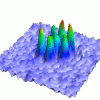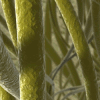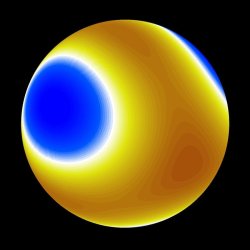-
Viewpoint on 'IONS'
Viewpoint on 'Scientific Literacy'
- Proudly sponsored by
-


-
Forging Quantum Teams

A rowing team consists of a given number of athletes; adding or subtracting one would make it impossible for the team to compete. Recent experiments have shown that conditions exist under which quantum particles can also team up in a controlled number.
-
The Ultracold Laser Show

In nightclubs and live concerts, figures or text are often outlined by quickly steering one single laser beam. The same principle has now been applied to drawing potentials onto ultracold gases: a new technique that could soon make its way into laboratories.
-
Forensic Optics: Transforming a Hair into a Travel Log

Solving crimes requires and complicated investigations in order to find clear evidence. Now, it is possible to obtain information about a suspect's travel history by analyzing their hair.
Volume 4 Story 5 - 16/3/2009
Squeezing the Most
Science relies on precise measurements. But how precise can a measurement be in principle? A new experiment shows a surprising new limit, together with a way around that limit.

Improvements in the ability to perform precise measurements have always laid the conditions for revolutionary inventions and discoveries. At the beginning of the 17th century, the improvement of telescopes led to
the endorsement of the heliocentric model, which was a key element in
the following scientific revolution. A few years later, the improvement of the microscope permitted the Dutch scientist van Leeuwenhoek to observe and describe single-celled organisms, paving the way for a whole new research field.
These days, our technology is mature enough that for some measurements the limit is no longer set by engineering constraints, like the lens quality, but by fundamental limits, limits set by the quantum behavior of nature itself. In a novel experiment, University of Toronto researchers Krister Shalm, Rob Adamson and Aephraim Steinberg have reached one of the most fundamental quantum limits, the Heisenberg limit. Their experiment sheds new light on the nature of squeezing and on the deep connection between squeezing and entanglement.
The Heisenberg uncertainty principle limits the precision with which complementary physical properties can be measured simultaneously. The more precise a measurement of a certain property is, the less precise will be the one of the complementary property — just like squeezing a balloon filled with water in one direction makes it automatically expand in the other.
When only the precision of one variable is important, while the uncertainty of the complementary one does not matter, the uncertainty of the first variable can be squeezed as hard as possible to get a very precise measurement of this property. Therefore, many recent experiments aim at a maximum amount of squeezing, implicitly assuming that there is no fundamental squeezing limit.
Generally speaking, the uncertainty decreases when more photons are used in the measurement. For classical states the uncertainty scales with 1/√N, where N is the number of photons. Squeezed states can in principle improve this scaling to 1/N, which is known as the Heisenberg limit. So far, in all experiments, the squeezed light consisted of millions of billions of photons (1015) and was far from the Heisenberg limit.
In the experiment by Shalm and coworkers, a squeezed state made out of only three photons was created. Shalm explains: "In our experiment, we studied the different directions that the electric field of light can oscillate as it moves through space. The direction the light field oscillates is known as its polarization, and different polarization directions are complementary to one another." With this polarization squeezed state they were able to reach the Heisenberg limit. "While state of the art squeezing experiments are still far away from the Heisenberg limit, in our experiment, we are able to squeeze right to the quantum limit in uncertainty. For us, this is easier because we only need to deal with three photons and have complete control over them." Their result is quite surprising: after a certain point, the squeezing does not improve the measurement anymore, but the opposite happens and more squeezing results in an increased uncertainty. It can be imagined that the balloon lies on a sphere and when the squeezing is hard enough, the other direction expands so far that it wraps around the sphere, a situation which Shalm and coworkers have termed over-squeezing.
But this is not the end of the story. Luckily, the research group led by Prof. Aephraim Steinberg found a way around this limit by taking advantage of another quantum property: entanglement. Entangled photons are photons that have lost part of their individuality and have to be treated in some sense as a single particle. The three photons in their experiment were entangled in their polarizations and therefore they showed collective behavior. When the photons were measured with detectors sensitive to single photons, the correlations between the photons were revealed giving more information and the measurement could be improved even further.
Geoff J. Pryde from Griffith University in Brisbane, an expert in the field of quantum measurements, explains: "These results make the link between squeezed states and multi-photon entangled states, which are often seen as two very different things. It is pointed out that really they are just two different regimes and in a system with only three photons there is not much difference between the regimes." This new method could be used to improve a variety of measurements. "The advantage of the produced states," Pryde adds, "is that they can obtain the maximum advantage for a given number of photons. In principle, the precision of measurements could be increased by a factor of √N, where N is the number of photons." For three photons this substantial improvement is still smaller than in squeezing experiments using a large number of photons, but the potential is huge and possible applications include better clocks and sensitive gravity wave detectors.
For most applications the number of entangled photons had to be scaled up to one thousand or more, which is considered a very difficult task in current systems. But if this could be achieved, the method would be directly applicable to "several low light applications where precision measurements are important," as Shalm says, e.g. in biomedical applications. "If you are only able to use thousand photons to image a sensitive cell so you do not destroy it or change its response, you would want to use those thousand photons in the most intelligent manner possible." The challenge therefore remains to make entangled states with more than a few particles. This might be easier in non-optical systems, like systems consisting of ions or molecules, but also in these systems it is currently very difficult to get more than a few particles entangled.
For other applications the number of entangled particles would have to be increased even more. Shalm is optimistic that with new advances in material science, even this could be possible in the far future. "If this can be achieved, then the field of precision measurements will undergo a minor revolution. Suddenly our apparatuses will become much more sensitive. Just as van Leeuwenhoek ushered in a new era for biology when he developed a microscope powerful enough to explore the astonishing world of microscopic organisms, our improved measurement apparatus will open up new realms of science to explore."

Video: Over-squeezing. The quantum uncertainty of the state can be represented as a blob on the surface of a sphere. As squeezing takes place, the blob begins to wrap around the sphere until the maximum squeezed state is reached. Movie Credit: Krister Shalm.
Squeezing the Most
out of Photons
Science relies on precise measurements. But how precise can a measurement be in principle? A new experiment shows a surprising new limit, together with a way around that limit.
Over-squeezing. After a certain point, the squeezing does not improve the measurement anymore, but the opposite happens and more squeezing results in an increased uncertainty. The orange area on the surface of the sphere represents the polarization of the three-photon state. If the uncertainty for the polarization in one direction is squeezed hard, the uncertainty in the other direction wraps around the sphere. Image Credit: Krister Shalm.
These days, our technology is mature enough that for some measurements the limit is no longer set by engineering constraints, like the lens quality, but by fundamental limits, limits set by the quantum behavior of nature itself. In a novel experiment, University of Toronto researchers Krister Shalm, Rob Adamson and Aephraim Steinberg have reached one of the most fundamental quantum limits, the Heisenberg limit. Their experiment sheds new light on the nature of squeezing and on the deep connection between squeezing and entanglement.
The Heisenberg uncertainty principle limits the precision with which complementary physical properties can be measured simultaneously. The more precise a measurement of a certain property is, the less precise will be the one of the complementary property — just like squeezing a balloon filled with water in one direction makes it automatically expand in the other.
When only the precision of one variable is important, while the uncertainty of the complementary one does not matter, the uncertainty of the first variable can be squeezed as hard as possible to get a very precise measurement of this property. Therefore, many recent experiments aim at a maximum amount of squeezing, implicitly assuming that there is no fundamental squeezing limit.
Generally speaking, the uncertainty decreases when more photons are used in the measurement. For classical states the uncertainty scales with 1/√N, where N is the number of photons. Squeezed states can in principle improve this scaling to 1/N, which is known as the Heisenberg limit. So far, in all experiments, the squeezed light consisted of millions of billions of photons (1015) and was far from the Heisenberg limit.
In the experiment by Shalm and coworkers, a squeezed state made out of only three photons was created. Shalm explains: "In our experiment, we studied the different directions that the electric field of light can oscillate as it moves through space. The direction the light field oscillates is known as its polarization, and different polarization directions are complementary to one another." With this polarization squeezed state they were able to reach the Heisenberg limit. "While state of the art squeezing experiments are still far away from the Heisenberg limit, in our experiment, we are able to squeeze right to the quantum limit in uncertainty. For us, this is easier because we only need to deal with three photons and have complete control over them." Their result is quite surprising: after a certain point, the squeezing does not improve the measurement anymore, but the opposite happens and more squeezing results in an increased uncertainty. It can be imagined that the balloon lies on a sphere and when the squeezing is hard enough, the other direction expands so far that it wraps around the sphere, a situation which Shalm and coworkers have termed over-squeezing.
But this is not the end of the story. Luckily, the research group led by Prof. Aephraim Steinberg found a way around this limit by taking advantage of another quantum property: entanglement. Entangled photons are photons that have lost part of their individuality and have to be treated in some sense as a single particle. The three photons in their experiment were entangled in their polarizations and therefore they showed collective behavior. When the photons were measured with detectors sensitive to single photons, the correlations between the photons were revealed giving more information and the measurement could be improved even further.
Geoff J. Pryde from Griffith University in Brisbane, an expert in the field of quantum measurements, explains: "These results make the link between squeezed states and multi-photon entangled states, which are often seen as two very different things. It is pointed out that really they are just two different regimes and in a system with only three photons there is not much difference between the regimes." This new method could be used to improve a variety of measurements. "The advantage of the produced states," Pryde adds, "is that they can obtain the maximum advantage for a given number of photons. In principle, the precision of measurements could be increased by a factor of √N, where N is the number of photons." For three photons this substantial improvement is still smaller than in squeezing experiments using a large number of photons, but the potential is huge and possible applications include better clocks and sensitive gravity wave detectors.
For most applications the number of entangled photons had to be scaled up to one thousand or more, which is considered a very difficult task in current systems. But if this could be achieved, the method would be directly applicable to "several low light applications where precision measurements are important," as Shalm says, e.g. in biomedical applications. "If you are only able to use thousand photons to image a sensitive cell so you do not destroy it or change its response, you would want to use those thousand photons in the most intelligent manner possible." The challenge therefore remains to make entangled states with more than a few particles. This might be easier in non-optical systems, like systems consisting of ions or molecules, but also in these systems it is currently very difficult to get more than a few particles entangled.
For other applications the number of entangled particles would have to be increased even more. Shalm is optimistic that with new advances in material science, even this could be possible in the far future. "If this can be achieved, then the field of precision measurements will undergo a minor revolution. Suddenly our apparatuses will become much more sensitive. Just as van Leeuwenhoek ushered in a new era for biology when he developed a microscope powerful enough to explore the astonishing world of microscopic organisms, our improved measurement apparatus will open up new realms of science to explore."
Florian Wolfgramm
2009 © Optics & Photonics Focus
FW is currently working on his doctoral thesis at ICFO - The Institute of Photonic Sciences, Barcelona (Spain).

L. K. Shalm, R. B. A. Adamson, and A. M. Steinberg, Squeezing and over-squeezing of triphotons, Nature (2009) 457, 67-70 (link).
Video: Over-squeezing. The quantum uncertainty of the state can be represented as a blob on the surface of a sphere. As squeezing takes place, the blob begins to wrap around the sphere until the maximum squeezed state is reached. Movie Credit: Krister Shalm.